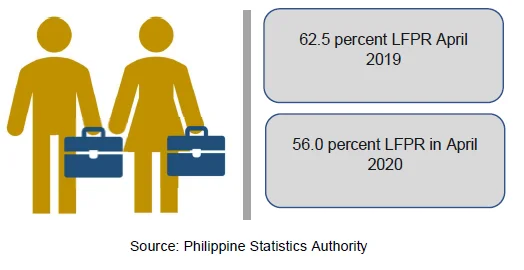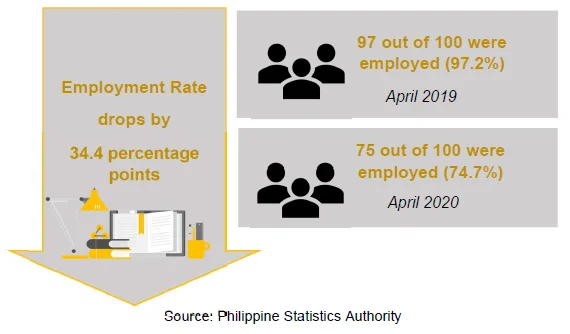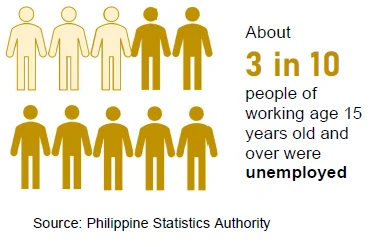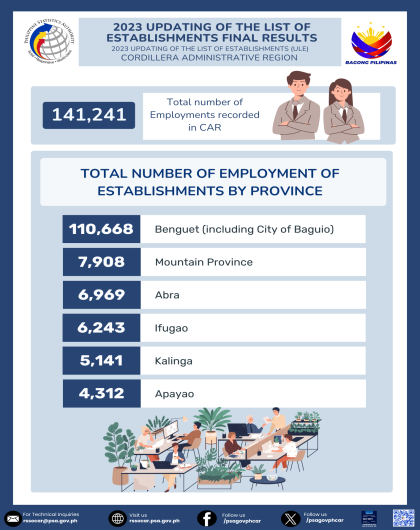The Labor Force Survey (LFS) is a nationwide quarterly survey of households conducted by the Philippine Statistics Authority (PSA) to gather data on the demographic and socioeconomic characteristics of the population. Specifically, the survey is designed to provide statistics on levels and trends of employment, unemployment and underemployment for the country, as a whole, and for each of the administrative regions.
Lower Labor Force Participation Rate in CAR recorded
- Based on the April 2020 Labor Force Survey (LFS), the total working population of 15 years old and over in the region was estimated at 688 thousand. This translates to 56.0 percent labor force participation (LFPR) rate, slightly higher than the average national labor force participation rate of 55.7 percent.
- Compared to the same quarter of the previous year, CAR’s LFPR in April 2019 was 62.5 percent, higher by 14.6 percentage points than this year’s LFPR.
Figure 1. Labor Force Participation Rate, CAR: April 2019 and 2020

Employment rate drops to 74.7%
- Of the working population in the region in April 2020, employment rate was estimated at 74.7 percent or equivalent to 514 thousand Cordillerans, much lower than the employment rate recorded in January 2020 at 92.7 percent (equivalent to 740 thousand employed persons). The sharp decline in employment rate can be attributed to the work stoppage in most business establishments due to the COVID-19 pandemic.
-
Comparing to the same quarter of the previous year (April 2019, employment rate dropped by 34.4 percentage points.
Figure 2. Employment Rate, CAR: April 2019 and 2020

- Unemployment rate in the region was recorded at 25.3 percent, translating to about 174 thousand unemployed Cordillerans in April 2020.
Figure 3. Unemployment Rate, CAR: April 2020

More males are employed
- In April 2020, about 60.8 percent of the estimated 514 thousand employed Cordillerans were males, while employed females were recorded at 39.2 percent.
- Junior high school graduates made up the highest share of employed persons with 25.1 percent, followed by the college graduates with 19.8 percent; while postsecondary undergraduates shared the least with 0.002 percent.
Almost a third of total employed persons are skilled agricultural, forestry, and fishing workers
- Among the subsectors, skilled agricultural forestry, and fishing workers comprised the largest number of employed individuals in the region in April 2020 accounting to 32.0 percent. In April 2019, this subsector shared 40.9 percent.
-
This was followed by elementary occupations with 31.8 percent share. Armed forces occupations and special occupations shared the least with 0.5 percent.
Figure 4. Percent Distribution of Employed Persons by Major Occupation
Group, CAR: April 2020

Wage and salary workers decrease
- Wage and salary workers are those who work for private households, private establishments, government and government-controlled corporations, and those who work with pay in own family-oriented farm or business. This class of workers accounted the largest share with 41.2 percent or 212 thousand out of the 514 thousand employed Cordillerans. This number of wage and salary workers decreased by 47.6 percent from the estimated 404 thousand workers a year ago.
-
The share of self-employed workers without any paid employee in April 2020 was 37.5 percent; worked without pay in own family-operated farm or business was 18.6 percent; and the least were self-employed workers in own family-oriented farm or business with 2.6 percent.
Not in the labor force increases
- Among the estimated population 15 years old and over in the region, about 44.0 percent were not in the labor force in April 2020, higher than the recorded 37.1 percent of the previous quarter of the same year.
-
Among those not in the labor force in January 2020, 62.5 percent were females, and 37.5 percent were males. Those not in the labor force include housewives, students, persons with disability, and those who have retired from their employment.


